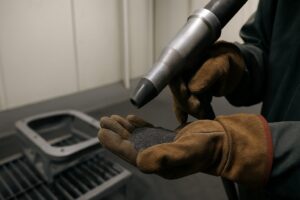Maintaining a sandblasting booth is essential for keeping your finishing operations running smoothly. Yet every minute your booth is offline for cleaning, calibration, or repair translates to production losses and missed deadlines. By taking a proactive, organized approach to booth maintenance, you can dramatically cut downtime and even turn maintenance into a competitive advantage. Here’s how.
Understand the True Cost of Downtime
It’s easy to shrug off maintenance as a necessary evil. But when you do the math, even an hour’s stoppage can add up. Consider labor waiting for the booth to come back online, the cost of idle equipment, and the ripple effect on production schedules. When you understand that downtime is more than just an inconvenience, it’s a drain on your bottom line— you’ll be motivated to streamline every step of the maintenance process.
Schedule Proactive, Predictable Maintenance
Reactive repairs, fixing things only after they break, are a recipe for surprise shutdowns. Instead, build a maintenance calendar based on manufacturer recommendations and real-world usage data. If your booth runs heavy-duty cycles five days a week, you may need filter changes or nozzle inspections monthly, rather than quarterly. Block out short, regular maintenance windows (for example, every first Saturday morning) and stick to them. Predictability means you can plan production around these windows and avoid last-minute scrambles.
Create a Standardized Maintenance Checklist
The secret to fast, consistent maintenance is a clear, step-by-step checklist. By standardizing procedures, you:
- Eliminate guesswork. Technicians know exactly which filters, seals, or nozzles need inspection and replacement.
- Speed up training. New hires can get up to speed quickly by following the same routine used by veteran staff.
- Track compliance. Simple signatures and dates on a printed form or digital log let you prove that maintenance was done correctly and on time.
Your checklist might include tasks like inspecting abrasive flow lines, cleaning collection hoppers, verifying pressure gauges, and wiping down interior surfaces. Lay them out in logical order so you move through the booth methodically.
Keep Spare Parts and Consumables On Hand
Nothing kills momentum like discovering mid-maintenance that you’re out of a critical gasket or filter. Analyze your usage history to forecast which parts wear out most often, then build a small inventory buffer. Organize spares in clearly labeled bins, group parts by booth section or maintenance task. When technicians know exactly where to find replacement nozzles, abrasive media, or air filters, they can swap them out immediately instead of hunting through a general supply room.
Train and Cross-Train Your Team
A well-trained maintenance crew is your best defense against lengthy shutdowns. Go beyond the basics: teach technicians how to diagnose common wear patterns, recognize early warning signs of motor or compressor strain, and use simple troubleshooting tools like vibration meters. Cross-training is equally vital. If only one technician knows how to rebuild the blast pot or replace the control panel, you’ll grind to a halt whenever that person is unavailable. Rotate responsibilities so multiple team members can perform every key task.
Leverage Technology for Predictive Insights
Modern sensor and monitoring technologies can turn maintenance from a guessing game into a data-driven process. Install pressure transducers, flow meters, and temperature sensors at key points, then feed that data into a simple dashboard. When you see pressure slipping below normal levels or motor temperature creeping upward, you know it’s time for inspection, before a catastrophic failure occurs. Predictive maintenance cuts unplanned downtime by catching issues early and scheduling repairs at convenient times.
Optimize Cleaning and Change-Out Procedures
Some maintenance steps, like abrasive change-outs or media recycling, can be especially time-consuming. Look for ways to streamline:
- Quick-release hoppers: Retrofit or specify hoppers that open with a simple latch instead of multiple bolts.
- Media reclaim units: Invest in a reclaim system that separates reusable abrasive automatically, reducing manual scooping and reducing fresh media purchases.
- Dry-ice blasting: For cleaning dust and debris off filters or interior panels, dry-ice blasting can be faster and less messy than manual brushing.
Any time you shave minutes off repetitive tasks, you’ll see maintenance windows shrink over the span of weeks and months.
Maintain Clear Communication with Production Teams
When maintenance is planned, everyone needs to know. Use a simple digital calendar or whiteboard in the production office to mark maintenance windows well in advance. Alert line managers and production schedulers so they can adjust assembly dates or shift priorities. Conversely, if maintenance uncovers an unexpected issue, say, a cracked viewport or failing motor bearing, quickly update stakeholders so they can reschedule downstream operations without scrambling.
Continuously Review and Improve
A maintenance plan isn’t set in stone. After each scheduled downtime, gather the maintenance crew for a brief debrief. Ask:
- What took longer than expected?
- Which steps could we eliminate or combine?
- Did we encounter any missing parts or tools?
- Were there any safety or quality hiccups?
Document these lessons and update your checklist or inventory plan accordingly. Over time, you’ll refine your processes to be faster, safer, and more cost-effective.
Foster a Culture That Values Preventive Care
Finally, instill a mindset that maintenance isn’t just overhead, it’s essential for quality work, employee safety, and customer satisfaction. Recognize your maintenance team when they hit milestones, like 100 consecutive days without unplanned downtime. Share before-and-after data showing how proactive care reduced lead times or boosted throughput. When everyone from the shop floor to upper management sees maintenance as a value driver rather than a burden, you’ll get buy-in for the tools, training, and spare-parts budgets you need.
Conclusion
Downtime in a sandblasting booth is unavoidable but it doesn’t have to be crippling. By scheduling maintenance thoughtfully, standardizing procedures, stocking spares, training your staff, leveraging data, and continuously improving, you can keep your booth humming along with minimal interruptions. The result? Happier customers, more consistent production, and a healthier bottom line. Make proactive maintenance your competitive edge, and watch your finishing shop thrive.
Specialized Sandblasting Booth Services
We specialize in providing top-quality sandblasting booths and custom finishing solutions tailored to meet the unique needs of various industries. Our expert team designs and manufactures state-of-the-art sandblasting booths that ensure safety, efficiency, and superior performance. From automotive and aerospace to marine and industrial applications, our booths are engineered to handle even the most demanding surface preparation tasks. We offer comprehensive services, including booth installation, maintenance.




